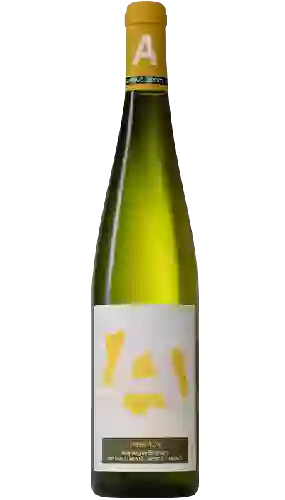
Cave du Roi DagobertLieu Dit Westerweingarten Riesling
In the mouth this white wine is a with a nice freshness.
This wine generally goes well with pork, vegetarian or rich fish (salmon, tuna etc).
Taste structure of the Lieu Dit Westerweingarten Riesling from the Cave du Roi Dagobert
Light | Bold | |
Dry | Sweet | |
Soft | Acidic |
In the mouth the Lieu Dit Westerweingarten Riesling of Cave du Roi Dagobert in the region of Alsace is a with a nice freshness.
Food and wine pairings with Lieu Dit Westerweingarten Riesling
Pairings that work perfectly with Lieu Dit Westerweingarten Riesling
Original food and wine pairings with Lieu Dit Westerweingarten Riesling
The Lieu Dit Westerweingarten Riesling of Cave du Roi Dagobert matches generally quite well with dishes of pork, rich fish (salmon, tuna etc) or spicy food such as recipes of spanish paella, sea bream a la plancha or couscous.
Details and technical informations about Cave du Roi Dagobert's Lieu Dit Westerweingarten Riesling.
Discover the grape variety: Riesling
White Riesling is a grape variety that originated in France (Alsace). It produces a variety of grape specially used for the elaboration of wine. It is rare to find this grape to eat on our tables. This variety of grape is characterized by small bunches, and small grapes. White Riesling can be found in many vineyards: Alsace, Loire Valley, Languedoc & Roussillon, Lorraine, Provence & Corsica, Rhone Valley, Savoie & Bugey, Beaujolais, South West.
Last vintages of this wine
The best vintages of Lieu Dit Westerweingarten Riesling from Cave du Roi Dagobert are 2013, 2012
Informations about the Cave du Roi Dagobert
The Cave du Roi Dagobert is one of of the world's great estates. It offers 89 wines for sale in the of Alsace to come and discover on site or to buy online.
The wine region of Alsace
Alsace, located in the extreme north-east of France, is Distinguished from other French wine regions by its strong Franco-Germanic influences. These influences are the result of a back-and-forth between the German and French sovereignties over the last few centuries. They can be seen not only in the architecture and culture of Alsace, but also in the wines. Alsace wines are produced under three main appellations: Alsace and Alsace Grand Cru for still white wines (Sweet and Dry), and Crémant d'Alsace for Sparkling wines.
News related to this wine
The Mâcon plus appellation investigated through its geology and geography
The Bourgogne Wine Board (BIVB) invites you to enjoy this video in which Jean-Pierre Renard, Expert Instructor at the Ecole des Vins de Bourgogne, explains the topographical and geological characteristics of the appellation Mâcon plus geographical denomination . The tectonics and the very different nature of the rocks that make up the subsoil of this region explain the great variety of soils found in this part fo Bourgogne. It also explains why each wine offers a different personnality. This vid ...
At the heart of the terroirs of Mâcon-Burgy
Sequence from the video « At the heart of the Mâcon terroir » which offer a stroll at the heart of the Mâcon terroir. It offers a focus on Mâcon-Burgy, one of the 27 geographical denominations of the Mâcon appellation. Travel through the terroirs of the Mâcon appellation by watching the full video : https://www.youtube.com/watch?v=GF20y1aBZh8 Both are availablein French and English. Our social media: Facebook: https://www.facebook.com/BourgogneWines Twitter: https://twitter.com/BourgogneWines/ ...
Geographical denomination: The first step towards the notion of terroir – Focus Bourgogne
We created this photomontage, to show you the landscapes and the different characteristics of the 14 geographical denominations of the Bourgogne appellation: Wine colors, grape varieties, soil specificities, surface area and production. You’ll become an expert on the Bourgogne appellation! Our social media: Facebook: https://www.facebook.com/BourgogneWines Twitter: https://twitter.com/BourgogneWines/ Instagram: https://www.instagram.com/vinsdebourgogne/ LinkedIn: https://www.linkedin.com/comp ...
The word of the wine: Mutage
The act of adding alcohol to a fresh grape must or to a fermenting must.













